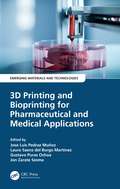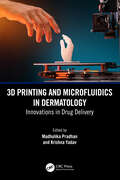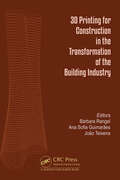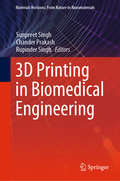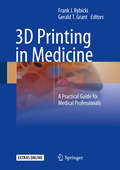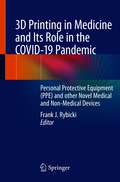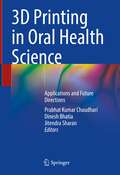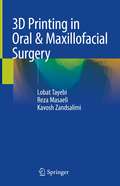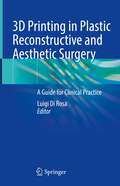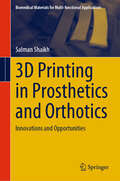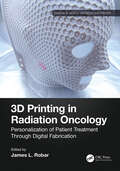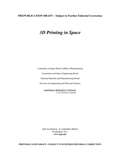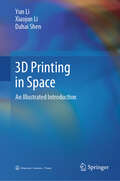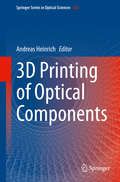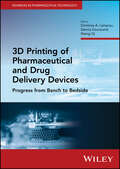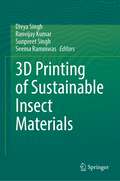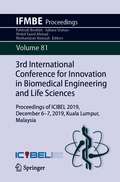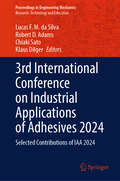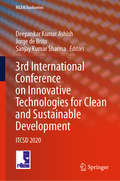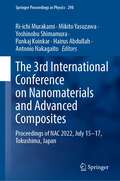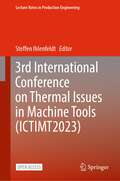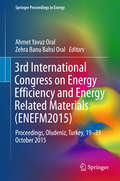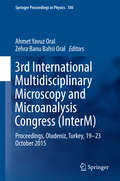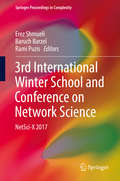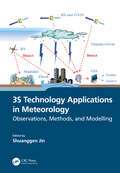- Table View
- List View
3D Printing and Bioprinting for Pharmaceutical and Medical Applications (Emerging Materials and Technologies)
by Jose Luis Pedraz Muñoz Laura Saenz del Burgo Martínez Gustavo Puras Ochoa Jon Zarate SesmaThe increasing availability and decreasing costs of 3D printing and bioprinting technologies are expanding opportunities to meet medical needs. 3D Printing and Bioprinting for Pharmaceutical and Medical Applications discusses emerging approaches related to these game-changer technologies in such areas as drug development, medical devices, and bioreactors. Key Features: Offers an overview of applications, the market, and regulatory analysis Analyzes market research of 3D printing and bioprinting technologies Reviews 3D printing of novel pharmaceutical dosage forms for personalized therapies and for medical devices, as well as the benefits of 3D printing for training purposes Covers 3D bioprinting technology, including the design of polymers and decellularized matrices for bio-inks development, elaboration of 3D models for drug evaluation, and 3D bioprinting for musculoskeletal, cardiovascular, central nervous system, ocular, and skin applications Provides risk-benefit analysis of each application Highlights bioreactors, regulatory aspects, frontiers, and challenges This book serves as an ideal reference for students, researchers, and professionals in materials science, bioengineering, the medical industry, and healthcare.
3D Printing and Microfluidics in Dermatology: Innovations in Drug Delivery
by Madhulika Pradhan Krishna Yadav3D Printing and Microfluidics in Dermatology provides a thorough exploration and applications of three-dimensional (3D) printing and microfluidics within the field of dermatology. It investigates various methods utilized in these fields, such as 3D bioprinting, nano-transporters, microscopic fabrication, and device development.The book not only examines practical applications but also delves into the design principles crucial for implementing these techniques using specific materials tailored to their intended purposes. Additionally, it addresses ethical concerns and regulatory considerations pertinent to these evolving technologies.Key highlights include the following: A detailed insight into the utilization of 3D printing and microfluidic technologies for treating skin disorders. Exploration of design concepts necessary for effective implementation, considering the unique properties of materials involved. Coverage of diverse methodologies, ranging from 3D bioprinting to nano-transporters, microscopic fabrication, and device engineering. In-depth discussion on ethical considerations vital for the sustainable development of the industry. Investigation into advancements in material development, device design, fabrication techniques, and performance evaluation through preclinical and clinical studies. This book targets graduate students and researchers in fields such as 3D printing, dermatology, drug delivery, bioengineering, and pharmaceutical sciences.
3D Printing for Construction in the Transformation of the Building Industry
by Bárbara Rangel Ana Sofia Guimarães João TeixeiraAs concrete revolutionised construction in the 20th century, digitalisation is transforming the building industry (BI). Process automation and 3D printing (3DP) are commonplace in the industry and our homes. However, due to BI’s scale and complexity, Additive Manufacturing (AM) is in its native stage. Ongoing scientific research has been providing knowledge that will simplify the integration of 3DCP in the market, exploring its materiality, technologies, and design methodologies. This book provides an overview of the latest research achievements of the design possibilities that 3DP for construction (3DC) can offer in the various fields of construction, particularly architecture and engineering.
3D Printing in Biomedical Engineering (Materials Horizons: From Nature to Nanomaterials)
by Sunpreet Singh Chander Prakash Rupinder SinghThis book gives a comprehensive overview of the rapidly evolving field of three-dimensional (3D) printing, and its increasing applications in the biomedical domain. 3D printing has distinct advantages like improved quality, cost-effectiveness, and higher efficiency compared to traditional manufacturing processes. Besides these advantages, current challenges and opportunities regarding choice of material, design, and efficiency are addressed in the book. Individual chapters also focus on select areas of applications such as surgical guides, tissue regeneration, artificial scaffolds and implants, and drug delivery and release. This book will be a valuable source of information for researchers and professionals interested in the expanding biomedical applications of 3D printing.
3D Printing in Medicine: A Practical Guide for Medical Professionals
by Frank J. Rybicki Gerald T. GrantThis book describes the fundamentals of three-dimensional (3D) printing, addresses the practical aspects of establishing a 3D printing service in a medical facility, and explains the enormous potential value of rendering images as 3D printed models capable of providing tactile feedback and tangible information on both anatomic and pathologic states. Individual chapters also focus on selected areas of applications for 3D printing, including musculoskeletal, craniomaxillofacial, cardiovascular, and neurosurgery applications. Challenges and opportunities related to training, materials and equipment, and guidelines are addressed, and the overall costs of a 3D printing lab and the balancing of these costs against clinical benefits are discussed. Radiologists, surgeons, and other physicians will find this book to be a rich source of information on the practicalities and expanding medical applications of 3D printing.
3D Printing in Medicine and Its Role in the COVID-19 Pandemic: Personal Protective Equipment (PPE) and other Novel Medical and Non-Medical Devices
by Frank J. RybickiThis book describes how “makers” with no medical experience became and remain clinically important because they utilized 3D printing to produce supplies for healthcare, including medical and non-medical devices, and to improve the quality of life for patients with COVID-19 and those who care for them. It shows how 3D printing became vital during the pandemic due to its broad availability and the inherently digital nature of the work that enables thriving digital exchanges and work in isolation. Subsequent chapters highlight some of the “maker” communities' efforts that made a difference in their part of North America. Each contribution describes the unique experiences, challenges, and successes.While this book is written and edited mostly from a medical perspective, additional input from medical engineers, administrators, attorneys, and public safety officials enables a broad perspective to highlight some of the ingenuity from the North American 3D printing community who responded to the initial case volumes of COVID-19.
3D Printing in Oral Health Science: Applications and Future Directions
by Prabhat Kumar Chaudhari Dinesh Bhatia Jitendra SharanThis book on 3D printing in oral health science aims to equip the reader with a sound understanding of contemporary clinical applications in all fields of dentistry and their future directions. In the last few years, the development of 3D printing for medical and dental applications has increased tremendously. Advancements in 3D printing create the possibility of customized products, savings on small-scale productions, ease of sharing and processing of patient image data, and educational up-gradation. Looking at the dental specialties, it is evident that 3D printing has applications in all aspects of oral health science including prosthodontics, oral surgery, periodontics, endodontics, and orthodontics. This book will cover all major fields in dentistry and will help the practitioner in the process of decision-making and apply concepts in clinical or laboratory practice. It is based on current scientific evidence to provide readers with an up-to-date contemporary understanding of the subject, both from the clinical and the technological side. The book is a valuable asset for all who specialize in 3D printing and for those interested in learning more about this field.
3D Printing in Oral & Maxillofacial Surgery
by Lobat Tayebi Reza Masaeli Kavosh ZandsalimiThis book is a comprehensive guide to 3D printing and 3D bioprinting methods and their application in oral and maxillofacial surgeries. Among the 3D printing methods considered are fused deposition modeling, selective laser sintering, photopolymer jetting, powder binder printing, and stereolithography, while the coverage of 3D bioprinting encompasses inkjet, microextrusion, and laser techniques. In each case, the relevance of the technique to oral and maxillofacial surgery is explained. In addition, the available inks and bioinks for 3D printing are reviewed. The roles of soft and hard tissue printing in oral and maxillofacial tissue engineering and the use of 3D printing in multi- and interfacial tissue engineering are then examined in depth. The particular value of 3D printing in the treatment of critically sized defects is discussed separately. Finally, up-to-date information is provided on guided tissue/bone regeneration using 3D printing. The book will be of interest to both oral and maxillofacial surgeons and biomedical engineers.
3D Printing in Plastic Reconstructive and Aesthetic Surgery: A Guide for Clinical Practice
by Luigi Di RosaThis handy volume illustrates the basics of clinical three-dimensional (3D) printing, addressing the practical aspects of establishing a simple and effective 3D printing service in a medical facility. No longer confined to makers and workshops, this very recent technology has been fast developing and rapid prototyping has proven its potential in the clinical field as well, leading to new approaches. The declared aim of this work is enabling medical professionals to create bespoke anatomical models from a series of CT or MRI images, and assisting them in choosing the best suited 3D printers and materials for each specific clinical need. The text includes original, full-color step-by-step photos for better guidance, and a complete review of related publications in literature. Single chapters devoted to specific areas of 3D printing application, such as rhinoplasty, ear reconstruction, oculoplasty, maxillofacial surgery, as well as for surgical simulations. Contents are completed by a review of the legal aspects and the safety and quality considerations, as well as a thorough examination of the variety of 3D printers, compatible materials as filaments and resins, and including the available online resources. Plastic, Ophthalmologic and Maxillofacial surgeons, and professionals dealing with surgical reconstruction, will find this guide to be a valuable companion for the understanding of 3D printing in clinical practice.
3D Printing in Prosthetics and Orthotics: Innovations and Opportunities (Biomedical Materials for Multi-functional Applications)
by Salman ShaikhThe subject focuses on the 3D printing applications in rehabilitation industry. It presents a detailed comparative analysis between the conventional methods and digital manufacturing process and materials. It covers the wide area of application of 3D printing in prosthetics and orthotics industry, covering invasive as well as non-invasive applications. This technology has the potential to revolutionize the way prosthetics and orthotics are designed and manufactured. This book, being interdisciplinary in nature, can greatly benefit students from various disciplines in science, design and engineering and technology field. The book highlights the applications of 3D printing and uses a combination of modernized teaching and didactic approach. The readers can gain a deeper understanding of the subject matter and learn about the latest developments and techniques in the field of digital manufacturing. This book also provides practical information and instructions that are necessary for application-related design consideration and helps the reader apply their knowledge in real-world situations. This book will help readers in developing critical thinking and problem-solving skills for engineering applications in healthcare, as 3D printing provides unique-customized solutions. Additionally, it can serve as valuable reference for professionals and students interested in applications of 3D printing in rehabilitation industry.
3D Printing in Radiation Oncology: Personalization of Patient Treatment Through Digital Fabrication (Imaging in Medical Diagnosis and Therapy)
by James L. Robar3D Printing in Radiation Oncology: Personalization of Patient Treatment Through Digital Fabrication presents a comprehensive and practical view of the many forms in which 3D printing is being integrated into radiation oncology practice. Radiation oncology employs among the most sophisticated digital technologies in medicine. Until recently, however, the “last mile” of treatment has required manually produced or generic devices for patient set up, positioning, control of surface dose, and delivery of brachytherapy treatment. 3D printing is already offering enhancements in both precision and efficiency through the digital design and fabrication of patient photon and electron bolus, customized surface and gynecological brachytherapy applicators, proton beam compensators and range shifters, patient immobilization, novel radiation detectors, and phantoms. Various innovations are disrupting decades-old practices in radiation therapy (RT) facilities, resulting in vital improvements in personalization of treatment and patient experience.An essential read for radiation oncologists, medical physicists, radiation therapists, oncology nurses, hospital administrators, engineers, and medical educators, this book is an indispensable resource for those bringing 3D printing to the RT clinic, looking to expand the role of 3D printing in their practice, or embarking upon related research and development.
3D Printing in Space
by Committee on Space-Based Additive ManufacturingAdditive manufacturing has the potential to positively affect human spaceflight operations by enabling the in-orbit manufacture of replacement parts and tools, which could reduce existing logistics requirements for the International Space Station and future long-duration human space missions. The benefits of in-space additive manufacturing for robotic spacecraft are far less clear, although this rapidly advancing technology can also potentially enable space-based construction of large structures and, perhaps someday, substantially in the future, entire spacecraft. Additive manufacturing can also help to reimagine a new space architecture that is not constrained by the design and manufacturing confines of gravity, current manufacturing processes, and launch-related structural stresses. The specific benefits and potential scope of additive manufacturing remain undetermined. The realities of what can be accomplished today, using this technology on the ground, demonstrate the substantial gaps between the vision for additive manufacturing in space and the limitations of the technology and the progress that has to be made to develop it for space use. "3D Printing in Space" evaluates the prospects of in-space additive manufacturing. This report examines the various technologies available and currently in development, and considers the possible impacts for crewed space operations and robotic spacecraft operations. Ground-based additive manufacturing is being rapidly developed by industry, and "3D Printing in Space" discusses government-industry investments in technology development. According to this report, the International Space Station provides an excellent opportunity for both civilian and military research on additive manufacturing technology. Additive manufacturing presents potential opportunities, both as a tool in a broad toolkit of options for space-based activities and as a potential paradigm-changing approach to designing hardware for in-space activities. This report makes recommendations for future research, suggests objectives for an additive manufacturing roadmap, and envisions opportunities for cooperation and joint development.
3D Printing in Space: An Illustrated Introduction
by Yun Li Xiaojun Li Dahai ShenThis book introduces an important and interesting aspect of space exploration technology: 3D printing in space. It explores the key techniques and application scenarios of this innovative technology. With several countries announcing moon missions, the dream of venturing into the vast universe is becoming a reality. 3D printing offers immense potential for space exploration efforts. Featuring over 100 color graphics, this book not only explains fundamental theories and research advances in an easily understandable way but also addresses practical questions like achieving "waste recycling" in spacecraft and printing "houses" on the moon's surface. Additionally, it provides insights on dealing with component failures during deep space missions. Drawing from the authors' extensive research and development work in satellite payload technology, this book combines solid theoretical knowledge with practical engineering experience. It is a valuable resource for students, researchers, and engineers interested in space exploration and astronautics. Let this book serve as a vessel for readers to embark on their journey through the sea of stars. The English translation of this book, originally in Chinese, was facilitated by artificial intelligence. The content was later revised by the author for accuracy.
3D Printing of Optical Components (Springer Series in Optical Sciences #233)
by Andreas HeinrichThis edited volume reviews the current state of the art in the additive manufacturing of optical componentry, exploring key principles, materials, processes and applications. A short introduction lets readers familiarize themselves with the fundamental principles of the 3D printing method. This is followed by a chapter on commonly-used and emerging materials for printing of optical components, and subsequent chapters are dedicated to specific topics and case studies. The high potential of additive manufactured optical components is presented based on different manufacturing techniques and accompanied with extensive examples – from nanooptics to large scale optics – and taking research and industrial perspectives. Readers are provided with an extensive overview of the new possibilities brought about by this alternative method for optical components manufacture. Finally, the limitations of the method with respect to manufacturing techniques, materials and optical properties of the generated objects are discussed. With contributions from experts in academia and industry, this work will appeal to a wide readership, from undergraduate students through engineers to researchers interested in modern methods of manufacturing optical components.
3D Printing of Pharmaceutical and Drug Delivery Devices: Progress from Bench to Bedside (Advances in Pharmaceutical Technology)
by Dimitrios A. Lamprou Dennis Douroumis Sheng Qi3D Printing of Pharmaceutical and Drug Delivery Devices 3D Printing of Pharmaceutical and Drug Delivery Devices Discover the latest, fast-developing technology to help move towards more cost-effective, small-batch, decentralized manufacturing of personalized systems 3D printing has revolutionized manufacturing. Its precision and flexibility have enabled the large-scale production of materials and devices too complex for conventional industrial manufacturing. This has been particularly revolutionary in the field of pharmaceutical production, where 3D printing is being integrated into the manufacture of both drugs and drug delivery devices. It has never been more important for industry professionals to understand this form of production. 3D Printing of Pharmaceuticals and Drug Delivery Devices: Progress from Bench to Bedside offers a comprehensive overview of 3D printing technology and its pharmaceutical applications. It introduces readers to a world in which bespoke drug delivery systems developed for specific users or conditions is rapidly becoming a reality. Its detailed coverage of strategies and industrial processes incorporates the latest research and real-world experience of production. 3D Printing of Pharmaceuticals and Drug Delivery Devices: Progress from Bench to Bedside readers will also find: A multi-disciplinary authorial team of industry leadersDiscussion of common technical and regulatory barriers and their possible solutionsFar-ranging discussion of pharmaceutical applications across all sectors 3D Printing of Pharmaceuticals and Drug Delivery Devices: Progress from Bench to Bedside is essential reading for pharmaceutical industry professionals and researchers looking to occupy the leading edge.
3D Printing of Sustainable Insect Materials
by Divya Singh Ranvijay Kumar Sunpreet Singh Seema RamniwasThis book compiles a diverse and interdisciplinary range of scientific literature, laboratory developments, industrial implications and future prospects covering Entomophagy in 3D food printing to fight against hunger and nutritional deficiencies. Recent developments in Entomphagy in 3D printing of Drosophila based materials, and their nutritional, social, economic, scientific and environmental aspects. are comprehensively covered. Readers will also find shortcomings, guidelines, and industrial prospects for these materials, with emphasis on processing methods for the extraction of sustainable materials through 3D food printing. 3D Printing of Sustainable Insect Materials focuses on the methodology, technology and processing used for utilizing insects in 3D food printing applications, establishing technology-driven knowledge to fight against hunger. Chapters cover the principles for Entomophagy, insect processing methods, modern 3D food printing technologies, and the theoretical and practical aspects of Emtomophagy in 3D printing, with a special focus on future prospects and technologies. This ground-breaking book will serve knowledge to researchers and industry professionals across the food industry with broad coverage of emerging technologies, materials developed through Entomophagy, functional characterization and the technical details required to produce sustainable insect-based materials through 3D food printing.
3rd International Conference for Innovation in Biomedical Engineering and Life Sciences: Proceedings of ICIBEL 2019, December 6-7, 2019, Kuala Lumpur, Malaysia (IFMBE Proceedings #81)
by Fatimah Ibrahim Juliana Usman Mohd Yazed Ahmad Norhamizan HamzahThis book presents innovative engineering solution for medical diagnosis, therapy and life science studies. Gathering the proceedings of the 3rd International Conference for Innovation in Biomedical Engineering and Life Sciences, ICIBEL 2020, held on December 6-7, 2019, in Kuala Lumpur, Malaysia, this book aims at informing on engineering tools and their clinical applications, and being a source of inspiration for future research and interdisciplinary collaborations.
3rd International Conference on Industrial Applications of Adhesives 2024: Selected Contributions of IAA 2024 (Proceedings in Engineering Mechanics)
by Robert D. Adams Chiaki Sato Lucas F. M. da Silva Klaus DilgerThis book offers selected papers presented at the 3rd International Conference on Industrial Applications of Adhesives, held in Cascais, Portugal, March 7-8, 2024. The goal of the conference was to provide a unique opportunity to exchange information, present the latest results as well as to discuss issues relevant to industrial applications of adhesives. Special contributions on formulation of adhesives, pressure sensitive adhesives, adhesive properties, design of adhesive joints, and durability of adhesive joints have been selected for this volume. This work will appeal to a wide readership, from practitioners through graduate students to researchers working in this field.
3rd International Conference on Innovative Technologies for Clean and Sustainable Development: ITCSD 2020 (RILEM Bookseries #29)
by Deepankar Kumar Ashish Jorge De Brito Sanjay Kumar SharmaThis book gathers peer-reviewed contributions presented at the 3rd International Conference on Innovative Technologies for Clean and Sustainable Development, held in Chandigarh, India, on February 19-21, 2020. The respective papers focus on sustainable materials science and cover topics including the durability and sustainability of concrete, green materials in construction, economics of cleaner production, environmental impact mitigation, innovative materials for sustainable construction, performance and sustainability of special concrete, renewable energy infrastructure, sustainability in road construction, sustainable concrete, sustainable construction materials, waste minimization & management, prevention and management of water pollution, and zero-energy buildings.
The 3rd International Conference on Nanomaterials and Advanced Composites: Proceedings of NAC 2022, July 15-17, Tokushima, Japan (Springer Proceedings in Physics #298)
by Ri-Ichi Murakami Mikito Yasuzawa Yoshinobu Shimamura Pankaj Koinkar Hairus Abdullah Antonio NakagaitoThis book presents selected articles from the 3rd International Conference on Nanomaterials and Advanced Composites (NAC 2022) held at Tokushima University in Japan. This event brought together leading researchers and professionals from academia and industry to present their latest findings and served as a platform for the exchange of ideas aiming for further collaborations. Participants from over six countries shared their most up-to-date knowledge in their respective fields covering nanotechnology, nanomaterials, and advanced composites. Even though this conference had both on-site and remotely connected attendees, the main purpose to promote the networking among academics, engineers, and students was fully achieved. This book is part of the effort to disseminate the knowledge gathered during this meeting. The collection of articles covers topics on advanced composites, nanomaterials, ecological materials, energy, microfluidics, crystal growth, and photocatalysis. This representative account of the conference is intended to provide new and useful insights for prospective studies in materials science and engineering.
3rd International Conference on Thermal Issues in Machine Tools (Lecture Notes in Production Engineering)
by Steffen IhlenfeldtThis open access conference proceedings contains all the papers presented at the ICTIMT 2023, the 3rd International Conference on Thermal Issues in Machine Tools. The event takes place in Dresden, the capital of Saxony, from March 21-23 2023. The conference is organized by the Chair of Machine Tools Development and Adaptive Controls of the Technische Universität Dresden.
3rd International Congress on Energy Efficiency and Energy Related Materials: Proceedings, Oludeniz, Turkey, 19–23 October 2015 (Springer Proceedings in Energy)
by Ahmet Yavuz Oral Zehra Banu Bahsi OralThe 3rd International Congress on Energy Efficiency and Energy Related Materials (ENEFM2015) was held from 19-23 October 2015. This congress focused on the latest developments of sustainable energy technologies, materials for sustainable energy applications and environmental and economic perspectives of energy. These proceedings included 40 peer-reviewed technical papers, submitted by leading academic and research institutions from over 23 countries and represented some of the most cutting-edge researches available. The sections included in the 40 papers are listed as follows: Solar Energy, Fuel cells, Hydrogen productions, Hydrogen storage, Energy storage, Energy saving, Biofuels and Bioenergy, Wind Energy, Nuclear Energy, Fossil Energy, Hydropower, Carbon capture and storage, Materials for renewable energy storage and conversion, Photovoltaics and solar cells, Fuel generation from renewables (catalysis), Carbon dioxide sequestration and conversion, Materials for energy saving, Thermoelectrics, Energy saving in buildings, Bio-Assessment and Toxicology, Air pollution from mobile and stationary sources, Transport of Air Pollutants, Environment-Friendly Construction and Development, Energy Management Systems.
3rd International Multidisciplinary Microscopy and Microanalysis Congress: Proceedings, Oludeniz, Turkey, 19-23 October 2015 (Springer Proceedings in Physics #186)
by Ahmet Yavuz Oral Zehra Banu Bahsi OralThe 3rd International Multidisciplinary Microscopy Congress (InterM2015), held from 19 to 23 October 2015, focused on the latest developments concerning applications of microscopy in the biological, physical and chemical sciences at all dimensional scales, advances in instrumentation, techniques in and educational materials on microscopy. These proceedings gather 17 peer-reviewed technical papers submitted by leading academic and research institutions from nine countries and representing some of the most cutting-edge research available.
3rd International Winter School and Conference on Network Science: NetSci-X 2017 (Springer Proceedings in Complexity)
by Erez Shmueli Baruch Barzel Rami PuzisThis book contains original research chapters related to the interdisciplinary field of complex networks spanning biological and environmental networks, social, technological, and economic networks. Many natural phenomena can be modeled as networks where nodes are the primitive compounds and links represent their interactions, similarities, or distances of sorts. Complex networks have an enormous impact on research in various fields like biology, social sciences, engineering, and cyber-security to name a few. The topology of a network often encompasses important information on the functionality and dynamics of the system or the phenomenon it represents. Network science is an emerging interdisciplinary discipline that provides tools and insights to researchers in a variety of domains. NetSci-X is the central winter conference within the field and brings together leading researchers and innovators to connect, meet, and establish interdisciplinary channels for collaboration. It is the largest and best known event in the area of network science. This text demonstrates how ideas formulated by authors with different backgrounds are transformed into models, methods, and algorithms that are used to study complex systems across different domains and will appeal to researchers and students within in the field.
3S Technology Applications in Meteorology: Observations, Methods, and Modelling
by Shuanggen JinSpatial information technology and its integration, such as remote sensing, geographic information systems (GIS), and global navigation satellite systems (GNSS), known as 3S technology, have been extensively utilized in managing and monitoring natural disasters. This book illustrates the 3S integrated applications in the field of meteorology and promotes the role of 3S in developing precise and intelligent meteorology. It presents the principles of 3S technology and the methods for monitoring different meteorological disasters and hazards as well as their application progress. The case studies from the United States, Japan, China, and Europe were conducted to help all countries understand the 3S technology functions in handling and monitoring severe meteorological hazards. FEATURES Presents integral observations from GNSS, GIS, and remote sensing in estimating and understanding meteorological changes Explains how to monitor and retrieve atmospheric parameter changes using GNSS and remote sensing Shows three-dimensional modelling and evaluations of meteorological variation processing based on GIS Helps meteorologists develop and use space-air-ground integrated observations for meteorological applications Illustrates the practices in monitoring meteorological hazards using space information techniques and case studies This book is intended for academics, researchers, and postgraduate students who specialize in geomatics, atmospheric science, and meteorology, as well as scientists who work in remote sensing and meteorology, and professionals who deal with meteorological hazards.
